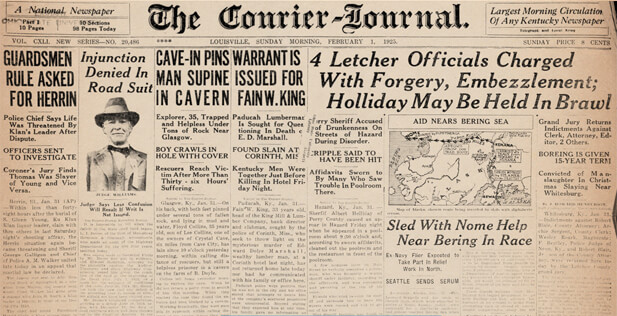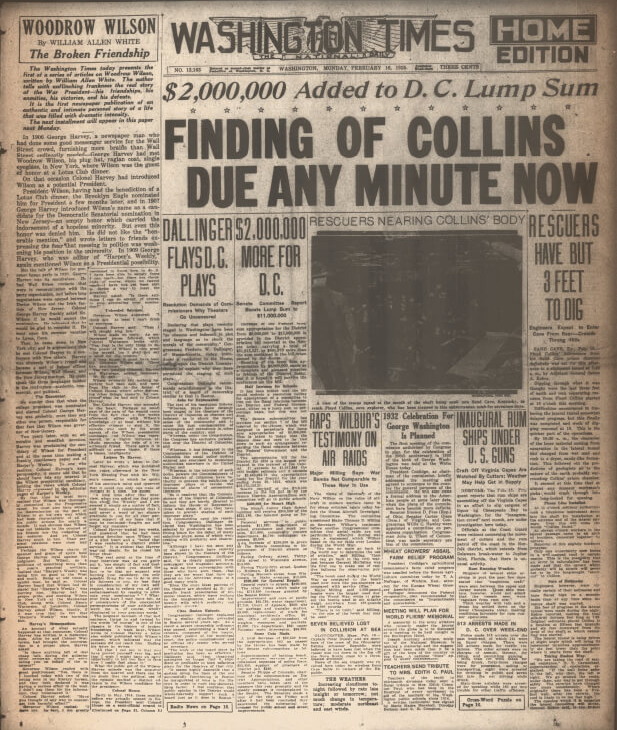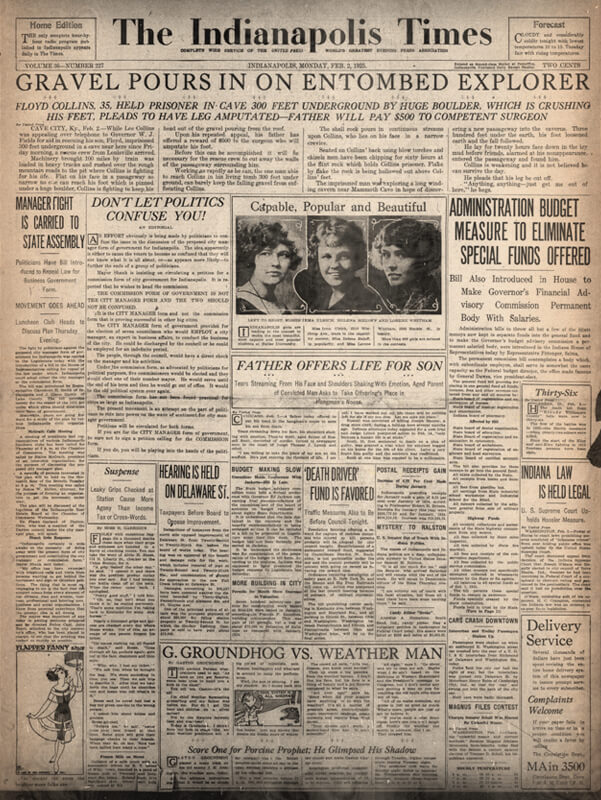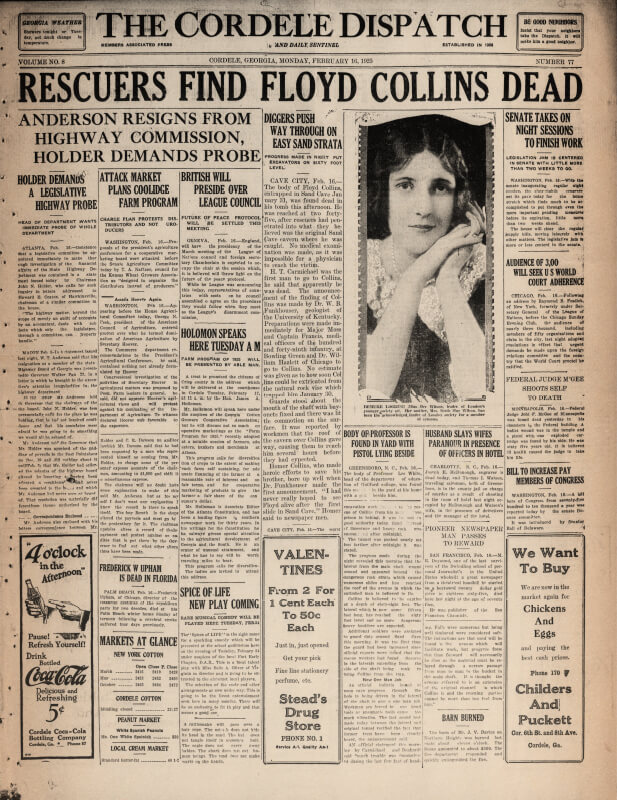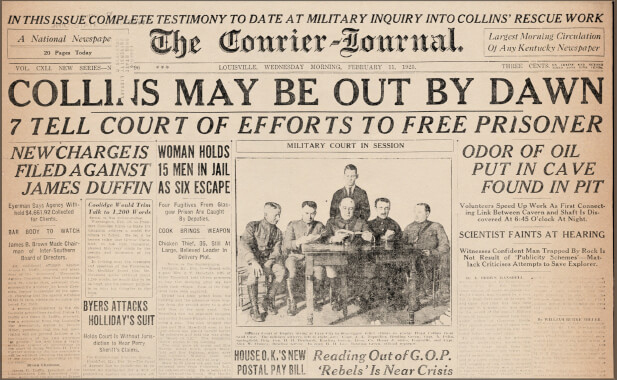Honoring Floyd Collins: The Life and Legacy of America’s Greatest Cave Explorer
William Floyd Collins was a Kentucky cave explorer who captured the nation’s attention when he became trapped in Sand Cave (now part of Mammoth Cave National Park), on January 30, 1925. His story captivated the nation for two weeks, and the rescue effort became one of the first major news events of the era. Sadly, Floyd passed away before being rescued. Today Floyd Collins has become a legend—his bravery and determination are immortalized in caving history. His story has been memorialized in songs, numerous books and has even inspired a Broadway musical.
The Early Years
Floyd Collins was born on the Collins family farm, located near Mammoth Cave, Kentucky, on July 20, 1887. His interest in caves began at a young age when, as a child, he ventured into caves to search for Native American artifacts to sell to tourists visiting the Mammoth Cave Hotel. In 1910 Floyd had already discovered his first cave, Donkey’s Cave, on the family farm, marking the beginning of his fascination with the underground world.
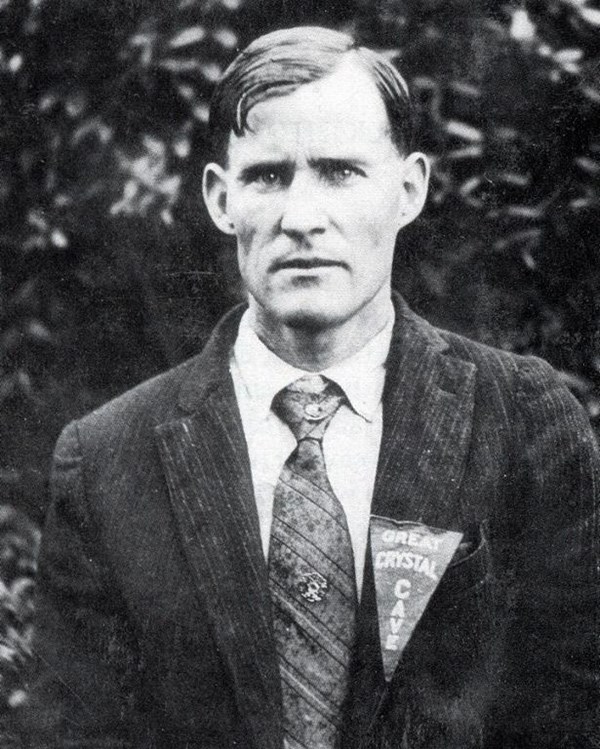
Floyd Collins (photo by Wade Highbaugh)
Great Crystal Cave
In September 1917, while exploring a bluff on the Collins family farm, Floyd noticed a breeze of cool air coming from a small hole in the ground. Intrigued, he widened the opening and descended into a cavity that led to a passage blocked by breakdown. Over the next few months, Floyd carefully cleared the blockage, eventually uncovering the sinkhole entrance in December 1917 to a cave he would later name “Great Crystal Cave.” Floyd’s father, Lee Collins, deeded him a half-interest in the cave, and the Collins family immediately set to work transforming it into a commercial attraction. After significant preparation, Great Crystal Cave was officially opened to tourists in April 1918 and ran as a family business until his death in 1925.
The Kentucky Cave Wars
During the early 20th century, the region was embroiled in what would become known as the “Kentucky Cave Wars,” a bitter competition among cave owners and explorers to capitalize on the growing demand for tourist attractions. Floyd’s discovery of Great Crystal Cave in 1917 was a significant achievement, but despite its stunning beauty, its remote location, far from the main tourist routes, meant it struggled to attract many visitors.
The Tragedy at Sand Cave
Determined to find a more profitable venture, Floyd hoped to find a cave entrance closer to the main road leading to Mammoth Cave. Floyd entered into an agreement with neighboring farmers who owned property closer to the main road. If he found a viable cave, they would create a partnership to share the business. He then began to explore a small cave on the property, working tirelessly to expand the entrance and make it more accessible to tourists. On January 30, 1925, while working alone in the cave, Floyd became trapped in a narrow crawlway, 55 feet below ground. A rock collapse pinned his left leg, and loose gravel buried his body, trapping him 150 feet from the entrance.
The subsequent rescue attempt became a national media sensation, and one of the first major news stories to be reported using the new technology of broadcast radio. For four days, rescuers were able to bring Floyd water and food, but a second rockfall sealed his position, leaving him isolated. During this time, attempts were made to dig through the breakdown and enlarge the passageway to reach Floyd. But, rescue leaders determined that that this was too dangerous and proposed digging a shaft down to reach the chamber behind where Floyd was trapped. On February 16th, rescuers finally reached Floyd but he was already dead. It was estimated that he had been dead for three to five days from thirst, hunger, and exposure to the cold. His body was recovered two months later.
Honoring Floyd’s Memory and Legacy
As we mark 100 years since Floyd’s passing, it’s important to reflect on his achievements and his role in cave exploration. Though Floyd was little known during his lifetime, the media attention surrounding his death catapulted him to fame. His posthumous recognition as the “Greatest Cave Explorer Ever Known” immortalized him in the annals of American history. His story has inspired a variety of artistic works, including the song The Death of Floyd Collins, which poignantly captures his tragic fate. In 1996, Floyd’s story was brought to the stage in the Broadway musical Floyd Collins. The musical is returning to Broadway, bringing Floyd’s story to a new generation of theatergoers.
Floyd Collins’ story is one of exploration, tragedy, and a lasting reminder of the need to protect the unique environments he so deeply loved. His tragic death highlighted the importance of responsible exploration, cave safety, and the preservation of delicate underground ecosystems. Although Floyd may have died young, his legacy of courage and his contributions to cave exploration continue to resonate. As we honor his memory, we also recognize the importance of preserving the caves he cherished and worked tirelessly to explore. Cave conservation is more important than ever, and by learning from Floyd’s life, we can ensure that future generations have the opportunity to experience the beauty of these natural wonders.
Protecting Caves Like Those That Floyd Loved
Today, organizations like the American Cave Conservation Association (ACCA) work to protect these natural wonders, educate the public on their importance, and safeguard the animals that call caves home, as well as the rich history many caves harbor. Our efforts help ensure that these delicate ecosystems are preserved for future generations. All proceeds from donations, memberships, Hidden River Cave admissions, and sales through the American Cave Museum gift shop go directly to support our mission of protecting caves, karstlands and groundwater resources.
Resources & Reading
https://rogerbrucker.com/trapped-the-story-of-floyd-collins
https://www.nps.gov/articles/000/tragedy-at-sand-cave.htm
https://en.wikipedia.org/wiki/Floyd_Collins
https://www.dvidshub.net/news/387999/kentucky-national-guard-and-william-floyd-collins-tragedy-sand-cave
2025 Commemorations & Events:
Mammoth Cave National Park Floyd Collins Tour (February 2025) – Includes visits to the Collins’s family homesite, Sand Cave overlook, and Mammoth Cave Baptis Church where Collins is buried as well as a tour in Crystal Cave. For information: https://www.nps.gov/maca/planyourvisit/floyd-collins-commemoration-2025.htm
https://broadwaydirect.com/show/floyd-collins/
https://playbill.com/article/floyd-collins-upcoming-broadway-debut-isnt-about-why-now-its-why-always
The American Cave Conservation Association (ACCA) is a National 501 (c) 3 Nonprofit Organization.
Donations and Memberships are Deductible to the Fullest Extent Allowed by Law.

